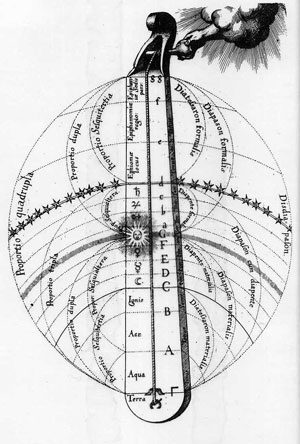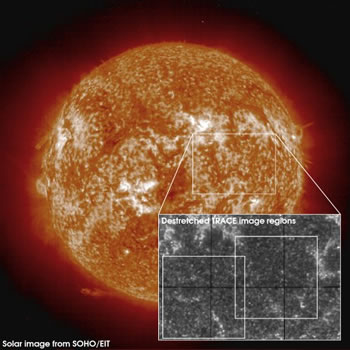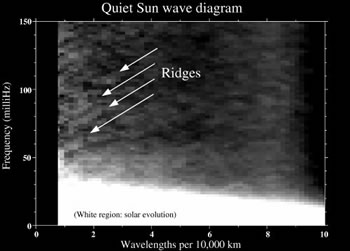Science Fiction
Dictionary
A B C D E F G H I J K L M N O P Q R S T U V W X Y Z
Solar Ultrasound - Bass Note In Music Of The Spheres

Ancient cosmology held that each of the planetary spheres corresponded to a different note in a universal musical scale. The tones emitted by the planets depended on the ratios of their different orbits in the same way that the length of a lyre-string determines its tone. The music of the spheres was contemplated by many respected philosophers, like Pythagoras, Plato, Pliny and Ptolemy. The English hermetic philospher Robert Fludd devised celestial scales that spanned three octaves, linking sub-planetary elemental worlds to angelic choruses beyond the stars.

(Robert Fludd's divine Monochord)
Now, in a letter published on December 10th in Astrophysical Journal Letters, researchers report that the Sun's atmosphere is filled with ultrasound-like waves at a frequency of about 100 millihertz - every ten seconds. "At 10-second period, these waves qualify as ultrasound because individual atoms on the Sun experience only a few collisions during the brief passage of each wave, just as with ultrasound here on Earth," says Dr. Craig DeForest, a senior research scientist in the SwRI Space Science and Engineering Division. DeForest found the signature in data collected in January 2003 in the TRACE program.
"These ripples seem to be carrying about 1 kilowatt of power per square meter on the surface of the Sun," says DeForest. "That is similar to the sonic energy you might find coming out of the speakers at a rock concert. Very loud."
Of course, sound cannot travel through the vacuum of interplanetary space. The TRACE spacecraft, in orbit around the Earth, is an ultraviolet telescope trained on the sun. TRACE data shows small fluctuations in the brightness of solar ultraviolet emissions. Solar ultrasound waves are too faint to be seen directly by TRACE. So, DeForest looked for patterns in the background noise of the telescope.

(From Solar Atmosphere)
This combined ultraviolet solar image shows the region of the solar atmosphere that was examined to find the waves. The full-Sun image was produced with the EIT telescope aboard the SOHO spacecraft (image courtesy of the SOHO EIT consortium), and the small inset shows the region that was examined with higher resolution by the TRACE telescope.
TRACE is the Transition Region and Coronal Explorer mission; it has an open data policy. TRACE data is available to anyone on the web. The intent of the program is to explore the magnetic field in the solar atmosphere; TRACE was launched in 1998 and uses a 30 centimeter apterture telescope with a 1024x1024 CCD collecting images over an 8.5 arc minute square field of view.
The waves or "ripples" are most likely created by the sudden collapse of magnetically induced electric currents (magnetic reconnection) or by lower frequency sound waves that crash like ocean waves as they make their way up from the surface of the Sun. Both of the sources are likely candidates for the source of the solar atmosphere's mysterious extra heat, making the new waves a valuable tool for exploring a decades-old mystery. "By examining these waves more closely, we should be able to discern the source of energy release in the solar atmosphere, just like you can tell by listening whether the car is running in a dark garage," says DeForest. "In both cases, something is releasing energy into the environment, and that release has a recognizable sonic signature."

(From Solar Ultrasound)
In this wave diagram, which summarizes nearly 1,000 TRACE images, the waves appear as sloped ridges, showing the presence of sound-like waves in the octave between 50 and 100 mHz. The waves travel about 1,000 times the speed of sound on Earth.
As far as I know, science fiction authors have never used a solar-sized mass as a musical instrument. However, sf is replete with other creative examples of instruments; see Isaac Asimov's visisonor or Jack Vance's stimic. Read more about TRACE, the music of the spheres and solar ultrasound.
Scroll down for more stories in the same category. (Story submitted 12/12/2004)
Follow this kind of news @Technovelgy.| Email | RSS | Blog It | Stumble | del.icio.us | Digg | Reddit |
Would
you like to contribute a story tip?
It's easy:
Get the URL of the story, and the related sf author, and add
it here.
Comment/Join discussion ( 5 )
Related News Stories - (" Space Tech ")
Will Space Stations Have Large Interior Spaces Again?
'They filed clumsily into the battleroom, like children in a swimming pool for the first time, clinging to the handholds along the side.' - Orson Scott Card, 1985.
Reflect Orbital Offers 'Sunlight on Demand' And Light Pollution
'I don't have to tell you about the seven two-mile-diameter orbital mirrors...'
Chrysalis Generation Ship to Alpha Centauri
'This was their world, their planet —
this swift-traveling, yet seemingly moveless vessel.' - Nat Schachner, 1934
The First Space Warship For Space Force
'Each of the electrical ships carried about twenty men...' - Garrett P. Serviss, 1898.
Technovelgy (that's tech-novel-gee!) is devoted to the creative science inventions and ideas of sf authors. Look for the Invention Category that interests you, the Glossary, the Invention Timeline, or see what's New.
Science Fiction
Timeline
1600-1899
1900-1939
1940's 1950's
1960's 1970's
1980's 1990's
2000's 2010's
Current News
Proof Of Robothood - Not A Person
'Who are you people? - Show 'em.'
Indonesian Clans Battle
'The observation vehicle was of that peculiar variety used in conveying a large number of people across rough terrain.'
The 'Last Mile' In China Crowded With Delivery Robots
Yes, it's a delivery robot. On wheels.
Tornyol Microdrone Kills Mosquitoes
'The real border was defended by... a swarm of quasi-independent aerostats.'
PLATO Spacecraft, Hunter Of Habitable Planets, Now Ready
'I ... set my automatic astronomical instruments to searching for a habitable planet.'
Factory Humanoid Robots Built By Humanoid Robots
'...haven't you a section of the factory where only robot labor is employed?'
iPhone Air Fulfils Jobs' Promise From 2007 - A Giant Screen!
'... oblongs were all over the floor and surfaces.'
ChatGPT Now Participates in Group Chats
'...the city was their laboratory in human psychology.'
iPhone Pocket All Sold Out!
'A long, strong, slender net...'
Did The Yautja Have These First?
What a marvel of ingenuity the little device was!
Jetson ONE Air Races Begin, Can Air Polo Be Far Behind?
'If you're one of those rarities who haven't attended a rocket-polo "carnage", let me tell you it's a colorful affair.'
Will Space Stations Have Large Interior Spaces Again?
'They filed clumsily into the battleroom, like children in a swimming pool for the first time, clinging to the handholds along the side.'
Mornine Sales Robot
'Robot-salesmen were everywhere, gesturing...'
Bipedal Robot Floats Gently While Walking
'a walking balloon proceeded with long strides of its aluminum legs...'
Musk Idea Of Cars Talking To Each Other Predicted 70 Years Ago
'My cars talk to one another.'
Elegant Bivouac Shelter Produces Water And Electricity
'There was nowhere on the planet where science and technology could not provide one with a comfortable home...'
